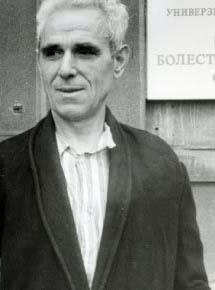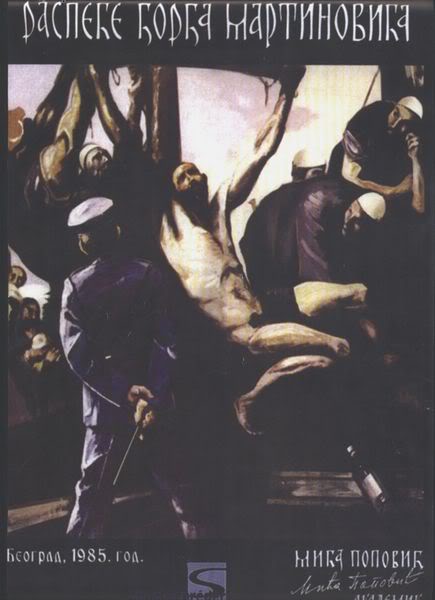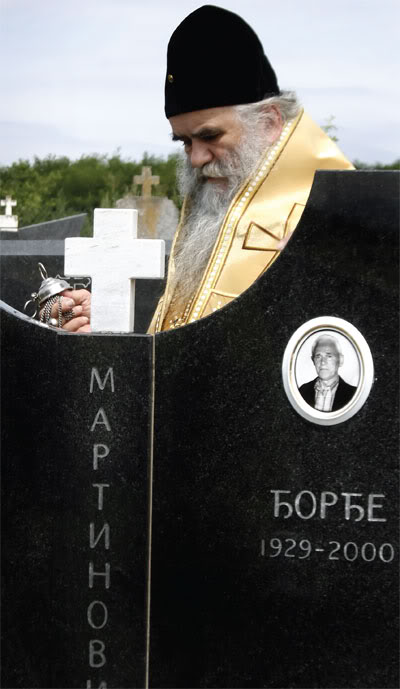Period:
SFR Yugoslavia
Region:
Kosovo and Metohia
Djordje Martinović (1929-2000) a Serbian victim from Gnjilane - Kosovo 1985
Djordje Martinović (1929-2000) was a Serb from Kosovo and Metohija, who suffered impalement with a broken glass bottle on the top. (Impalement, as a method of torture and execution, is the penetration of a human by an object such as a stake, pole, spear, or hook, often by the complete or partial perforation of the torso).
This cruel act happened in 1985 as one of many crimes committed by Albanians during ethnic tensions in Kosovo and Metohija. The communist regime of Yugoslavia ignored the existence of the ethnic tensions and put all their efforts to conceal this bizarre case indicating that it was an act of self-injury, despite the medical report stating the opposite.
The official self-injury report was rejected by the court decision in 1990, which, however, has never been implemented.
The case provoked great discontent among Serbs from Kosovo, followed by their migration to Central Serbia and Vojvodina, which had already been in progress. Đorđe Martinović was born in 1929 in Gnjilane.
The case of Djordje Martinović is one of the most widely debated criminal cases in ex-Yugoslavia and it became a symbol of suffering, concealing of truth, and media manipulation. It has also announced future events in Kosovo and Metohija, but in the entire of ex-Yugoslavia, as well.

Documentaries made by Milorad Bajić have never been broadcasted so far. Even Slobodan Milošević never answered the letter that Bajić sent to him regarding the suffering of Djordje Martinović.
|
ALBANIAN CRIMES AGAINST SERBS
|
| CRIMES |
Gorazdevac * March pogrom * April war * Kosovo's Spring * Plav end Gusinje
Radonjic's Lake * Pub Panda * Klecka * Mirovica's Marketplace * Bloody harvest
Bus of Livadice * Urosevac *
|
| CAMPS |
Likovac * Lapusnik * Kukesh * Yellow house * Plav * Balbaloc
|
| VICTIMS |
Branka Vasojevka * Baby of Grace * Danilo Milincic * Djordje Martinovic
Hariton Lukic * Shutakovic * Bosiljka Pasjanska * Srdjan Perovic
Ivan Bulatovic *
|
| CRIMINALS |
Ramush Haradinaj * Hasim Thaci * Adem Jashari * Agim Ramadani
Bedri Pejani * Shefket Verlaci * Midhat Frasheri * Mehmed Gradica
Skenderbeg Division * Prizren's League * Bali Kombetar * Agim Ceku
Rustem Mustafa * Kadri Veselji * Kujtim Berisha * Sulejman Selimi
Sali B. * Ibrahim Rugova * Enver Hodza * Redzep Majdani * Petro Koci
Ljuan Hajdraga * Mustafa Kruja
|
| PUBLICAT. |
Eyes of Patriarch * Empty house * Mother Ilaria * Abducation Kosovo
Dick Marty * Albanization Serbs * Without punishment *
|
SUFFERING
On 1 May 1985 at 1 pm, Kosovo Albanians caught Đorđe Martinović at his field and performed impalement with a glass bottle on the top of the wooden stick. The bottle penetrated through the anus and reached the intestines. It got stuck under the right subcoastal arch.
Martinović used all his remaining strength to reach the road, where he was found and taken to the hospital in Priština. At first, two Albanian surgeons tried to perform an urgent surgery of taking the bottle out. They later called dr. Moračić because they were afraid to take out the pieces of the broken bottle. After the surgery, dr. Moračić described the scene as horrifying.
The first news report regarding the incident was published three days later on 4th May 1985, in Belgrade daily newspaper Politika:
“The official of JNA home in Gnjilane, Djordje Martinović was subjected to impalement on 1 May at his field Jaruga, two kilometers away of Gnjilane. This cruel act was committed by Shqiptar terrorists.”
At first, official authorities in Gnjilane confirmed the act of crime, which was later supported by reports of medical experts.

This crime in Gnjilane was covered by the entire domestic press, even some foreign media.
SUDDEN CHANGE OF PERSPECTIVE
The case pulled off the public upset in Yugoslavia. It soon became the symbol of violence against Serbs in Kosovo and Metohija, and Serbian discontent and feeling of insecurity.
Among the members of the Yugoslav regime, fear was spreading that the incident would shatter the official ideology of brotherhood and unity of all Yugoslav nations and that the fact that a Serb was the victim of ethnically and religiously motivated crime would strengthen Serbian nationalism or even spark their protests in Yugoslavia. For these reasons, the regime in Belgrade decided to change the background of the case so that it was not attributed to ethnic Albanians. The case was led by a Slovenian Stane Dolanc, secretary of internal Affairs and director of the Counterintelligence of SFRY.
While Djordje Martinović was in life-threatening condition, he was visited by his superior, JNA colonel and commander of JNA Home in Gnjilane, Nikola Ivanović, who tried to force him to confess that he had injured himself during a homosexual, autoerotic practice. In his confession given a year later, colonel Ivanović admitted that, for this act, he received an order from general Stojanović. After this testimony, Ivanović got another post in Zrenjanin.

Djordje Martinović was transported from Priština to the Military Medical Academy in Belgrade where he had additional surgery. The team made of five doctors and led by dr. Ćeramilac signed a diagnosis report confirming that the act of self-injury in this way was not possible. As this was not enough, additional expertise was requested, which confirmed previous results. Nevertheless, the new examination was initiated by a professor from Ljubljana, Janez Malčinski, who gave the opposite statement in the report that self-injury was not excluded.
All that time, while Djordje Martinović was in the hospital in Belgrade, the justice officials Vukašin Trumpić and Gradimir Popović continued to force Djordje in the presence of the police to admit that he committed self-injury. The head of the Military Medical Academy general Vladimir Vojvodić allowed this interrogation. His deputy Srdjan Krstinić, later admiral in the Army of the Republic of Croatia, insisted on throwing Martinović out of the hospital.
Djordje Martinović was sent to London, where he had two surgery performed by a colorectal Surgeon, dr Peter Holy. After the surgery, the doctor said:
“Self-injury is entirely excluded as an option, I’ve studied the crime with my team after examination of medical documentation. The violent act was performed by at least three perpetrators!”
After this statement, Janez Malčinski sent a threatening letter to doctor Peter because “he intervenes in the internal affairs of Yugoslavia“. The official conclusion of the regime was different and opposite to their first statement in Gnjilane. It was supported by the results from Ljubljana and the coerced confession of Djordje Martinović. The official report said that 56-year-old Martinović was indulged in homosexual masturbation activity which resulted in injury. He then blamed Albanian separatists for this unpleasant incident while trying to use it to demonize Albanians and present Serbs as victims. Stane Dolanc gave his final statement regarding the case in 1987 on Slovenian television:
“The case of Djordje Martinović is closed. My police proved that he has injured himself, so there will be no trial. Djordje is the first Serbian samurai that tried to commit harakiri.”
The statement was followed by the laugh of journalists.
In protest, the group of Serbian intellectuals and journalists wrote an open letter entitled “The impaled truth”. A novelist, Dobrica Ćosić asked for a righteous investigation in his open letter to JNA admiral Branko Mamula and president of the Serbian Parliament, Dušan Čkrebić. He didn’t get an answer.
The Federal Parliament of Yugoslavia discussed “the case of Djordje Martinović” at eight meetings but without results. At the Serbian Republic Parliament, the discussion was delayed six times under the excuse that the Parliament was not authorized to deal with this case. The regional Albanian-dominated authorities in Kosovo supported the self-injury theory. JNA general Milan Daljević from the Yugoslav General Staff stated that JNA wasn’t connected with the case in any way. JNA general, Petar Gračanin, who became a new Internal Affairs secretary requested the final closure of the case. Federal prosecutor, Miloš Bakić was highly awarded because, among other things, he led the investigation in the case of Djordje Martinović very well.
In 1986, The New York Times published an article “In One Yugoslav Province, Serbs Fear The Ethnic Albanians” where the case was described as the one that “has become the most widely discussed Yugoslav criminal case in years, debated in Parliament and covered in full detail by television and the press”.
YEARS LATER
After Djordje Martinović filed a lawsuit, the second basic court in Belgrade issued a verdict in 1990, declaring the state guilty of defamation, obstruction, and hiding the truth. The court declared that Martinović was subjected to violence, taking into account the statement of Dr. Holy and the special committee led by dr. Vladimir Dodžić. The state was obliged to make compensation in the amount of 150,000 Deutschmark. However, the medical reports disappeared somehow and compensation has never been paid.
A director, Milorad Bajić said that federal secretary of the Internal Affairs Petar Gračanin and JNA admiral Branko Mamula obstructed the execution of the judgment by ordering the file to be archived in the Archive of the Yugoslav General Staff.
After five surgeries, Djordje Martinović faced tremendous pressure to sell his field in Gnjilane, which he did, eventually. He moved to the village of Čitluk near the city of Kruševac, where he died on 6 September 2000. He left his wife Jagodinka, three sons, a daughter, and 10 grandchildren. All of his sons and two oldest grandchildren were mobilized during the NATO aggression against Serbia and Montenegro in 1999.
.jpg)
The funeral of Djordje Martinović
The Golgotha of Djordje Martinović was painted by Mića Popović in 1985. He named his painting “The Cruxification of Djordje Martinović” which represents him crucified on the cross and watched by the communist regime.
Milorad Bajić made two documentaries “The fear of truth” and “We blame”. The only time when documentaries were broadcasted was in 1986 at the Festival of Documentaries in Dom Sindikata in Belgrade. From that time, each general director of Radio-Television of Serbia refused to broadcast the documentaries on this national television- Dušan Mitević, Radomir Vico, Milorad Vučelić, Dragoljub Milanović, Aleksandar Crkvenjakov, and Aleksandar Tijanić.
General director of BK television, Bojana Lekić also refused to allow broadcasting of the movies. Milorad Bajić was called several times to bring movies, yet every time the order on cancellation came in last minute. In 2006, 350 students- members of the Parliament of the Faculty of Law in Belgrade, Milorad Bajić, Mladen Mrkalj, dr. Zoran Krivokapić, who was one of the doctors that treated Djordje, and prof. Dr. Svetislav Nikić signed an open letter to President Boris Tadić and prime minister dr. Vojislav Koštunica to allow broadcasting of the movies.
Glas javnosti indicated that the case was a trigger of later events in Kosovo and Metohija and Yugoslavia and that it also affected the developments at the famous 8th Meeting of the Communist Central Committee that occurred a year later. As a symbol and metaphor, the case was mentioned four times at the trial to Slobodan Milošević in the Hague Tribunal.
Regarding the illegal secession and recognition of Kosovo and Metohija in 2008, a novelist Svetlana Velmar-Janković wrote an article, where she recalled the case of Djordje Martinović stating that “the case symbolized all the future cases of Serbian suffering.” Archbishop of the Serbian Orthodox Church, Atanasije Jeftić wrote that “this poor man is a living symbol of the suffering of Serbian people in Kosovo from the occupation of 1941 until the occupation of 1990 that started on the Saint Sava’s Day.”

Although the case of Djordje Martinović received considerable public attention in Yugoslavia, it was just one of many cases of violence against the non-Albanian population in Kosovo and Metohija that happened during the 1980s. Discontent and the indifferent attitude of the communist regime towards Albanian violence, and the political solution suggested by Slobodan Milošević were the main reasons for his subsequent rise to power.
Tags:
Please, vote for this article:
Visited: 13490 point
Number of votes: 64
|